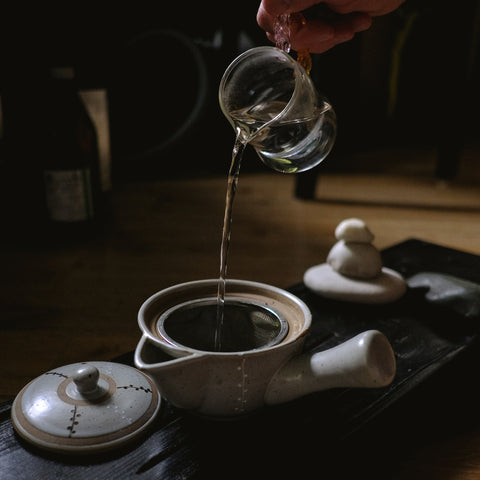
The Japanese brewing method is not only a beautiful ritual that invites mindfulness into one’s day, it also allows the final cup of tea to taste as its grower intended.
Whether you’re preparing a cup of sencha, genmaicha, hojicha or another of your favorite Japanese green teas, this guide will teach you how to do so using traditional Japanese techniques and utensils.
Step 1: Choose your utensils.
The key to preparing any kind of loose leaf tea is using a brewing tool that allows the tea leaves to fully expand. Unlike most tea strainers on the market, Japanese tea pots are designed to enable the tea leaves to open entirely as they steep, thus bringing out the full spectrum of their flavors.
Our personal favorite is the kyusu, a clay teapot utilized for brewing a wide variety of Japanese teas. The clay of the pot retains heat considerably and, hence, allows for shorter steeping times. Certain types of clay like Banko-yaki clay also reduce the tea’s astringency, making for softer flavors.
If you’re new to Japanese tea and not quite ready to invest in a proper tea pot, use a brewing basket or mesh tea ball. With the right water temperature and leaf to water ratio, this affordable utensil can still bring out a fine green tea. Eco-friendly tea filters are another option if you're looking solely for convenience.
Step 2: Get the right leaf to water ratio.
Japanese green tea varies greatly, and each type has its own unique flavor. For example, while genmaicha produces toasty, nutty flavors, senchas tend to be grassier and sweeter. Having too much leaf can exaggerate the intended flavor, while using too little will result in an understated liquor.
To get the correct ratio, first determine the water capacity of your tea pot, then use the guidelines below (or those listed on the label of your tea) to determine the amount of leaf to use.

Pro Tip: It’s best to use a small electronic scale to weigh your leaves, but you can use a teaspoon to measure, as well.
Step 3: Determine the appropriate water temperature.
I often hear people say that they don’t like the taste of green tea because it’s too bitter. While green tea can be more astringent than other types, the fact of the matter is that most people (even those working at high-end cafes) are brewing it at too high of a temperature!
Temperatures that are too high overly extract green tea’s natural components that give it a bitter taste. Use these temperature guidelines when brewing green tea:

To heat your water to the designated temperature, you’ve got a few options. The easiest is using a temperature-controlled electric kettle. You can also use a food thermometer.
If you’d rather use the traditional Japanese method (which, in my opinion, is a must when entertaining guests), first bring the water to a boil. Then, pour the boiling water into the empty kyusu or other type of tea pot and let it sit for about 30 seconds. (This will warm the teapot and lower the water’s temperature to about 195°F.)
Next, pour the water from the tea pot into empty teacups to further reduce the temperature and warm the cups. Discard excess water from the kyusu. Finally, add the leaves to the kyusu, and pour the water from the cups back into the pot over the leaves. By this point, the water will be around 160°F, ideal for brewing sencha.
If you need hotter water to brew genmaicha or hojicha, simply pour the boiling water into a small pitcher for about 30 seconds before transferring it into the kyusu on the leaves.

Pro Tip: Tap water, hard water, distilled water and reverse osmosis water can negatively impact the flavor of tea. For the best-tasting tea, I suggest using spring water.
Step 4: Steep the tea.
Steep the tea using the guidelines below or the parameters on the label.

While steeping green tea, do not shake or swirl the teapot, as this can cause the tea to become bitter.
Once the tea has steeped for the appropriate amount of time, slowly pour it into the cups, filling each cup to about ¼ of its capacity. Then, repeat, pouring bit by bit, until the very last little drop has been poured. This will help to ensure the taste and quantity of the tea are the same in each cup.
Alternatively, you can pour the entire pot into a small pitcher and then pour directly into the teacups.
Pro Tip: If you find the flavor of the tea too strong, consider shortening the steep time. If you find it too weak, extend the steep time. Everyone has different tastes, so it’s worth experimenting with this parameter.

Step 5: Re-steep.
Did you know that once brewed, you can still get even more flavor out of your green tea leaves?
Unlike Chinese oolong and black teas, which can be re-steeped a dozen or so times, Japanese green teas are limited by their delicate nature. Nevertheless, you can still get about two to three steeps out of them, in general.
With Japanese green tea, it’s best to re-steep the leaves as soon as possible, as leaving them wet makes them prone to degradation. When you’re ready to re-steep, simply follow the same brewing steps outlined above, but raise the temperature of the water about 15 to 20 degrees for each subsequent infusion.
Pro Tip: Between infusions, remove the lid of the teapot to allow the inside of the pot to cool. This prevents the tea leaves from continuing to steep between infusions.
Step 6: Store.
Tea should be stored away from light, air, heat, moisture and strong odors. If stored properly, unopened Japanese green tea will keep fresh for about a year.
Once tea has been opened and exposed to light, air, heat, moisture and/or odors, its freshness can deteriorate very quickly. Therefore, we recommend consuming the tea within a couple months, and storing it in a tea canister.
With a little practice, you’ll be a Japanese tea expert in no time!
